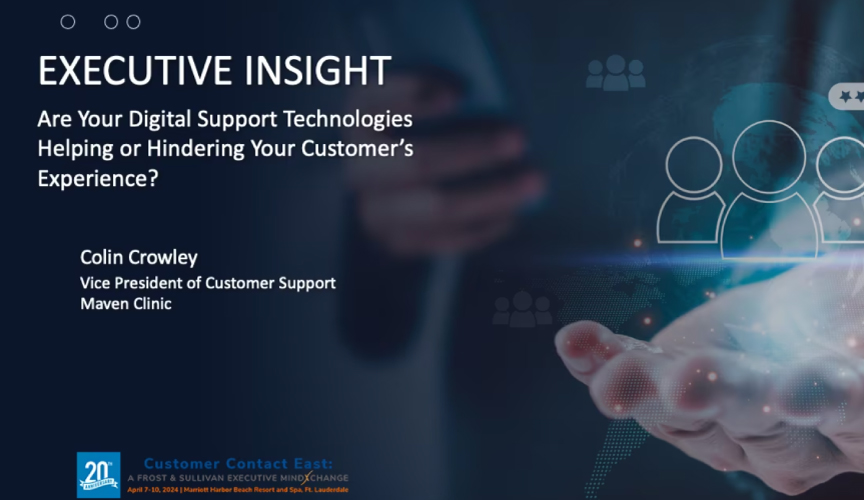Participants at Frost & Sullivan’s recent Customer Experience 2024 event in Orlando, Florida, learned from thought leaders from Marriott International, Whirlpool Corporation, Nordstrom, Foresters Financial, and many other notable companies. In addition to headliner presentations, panel discussions and roundtables, they engaged in hands-on crowdsourcing sessions, aka “Fixes,” where they discussed and brainstormed solutions to some of todays’ most vexing customer service challenges. Each brainstorming group built upon the other to create a list of readily operationalized ideas, with key solutions summarized below:
The Fix on Engaging Employees to Provide the Best Service in a Virtual Workplace
Moderated by Vanessa Neurohr, Vice President of Customer Success, MuckRack
To further engage employees, consider:
- Increasing the frequency of team meetings
- Asking employees to keep video on
- Conducting focus groups and skip level meetings (where direct managers don’t attend)
- Planning summer and holiday events
- Celebrating customer service week
- Having virtual coffee chats
- Experimenting with closing the call center for key team meetings
- Funding local meet ups (if there are at least 10 employees in a city)
- Giving out gifts, gift cards or other incentives to help employees feel valued
- Sending bi-weekly communications from management that don’t ask for anything in return
- Implementing real time training/shadowing/simulating
ACTION ITEMS
- Create committees composed of employees so they can take ownership
- Let employees take the lead in engaging and recruiting peers
- Make sure leaders are in regular communication with employees
- Get to know your employees, ask how they are doing
- Build relationships, listen and make sure the employees can ask questions, too
The Fix on CX Surveys with Actionable Impact
Moderated by Pamela Fusting, Director of Operations, CX, State of Tennessee Department of Human Services
Participants addressed the following three questions:
- What are the some of the ways surveys can garner insights?
- Survey at multiple, discrete customer touchpoints include different channels, focus groups and community forums
- Keep questions concise and surveys short to combat survey fatigue
- Minimize rating scale confusion (3 point like versus 5, happy face/sad face)
- Be sure to survey a broad/diverse customer base
- Survey in timely fashion … but not TOO soon (perhaps 24-hour turn-around)
- Get insights from your complaint management process (open-ended comments, sentiment analysis)
- Don’t forget social media monitoring and call recordings
- Consider using targeted invites and incentives to increase response rate
- Once gathered, how do you prioritize your insights for action?
- Include prioritization questions in the survey itself
- For example, ask customers, “What is most important?”
- Prepare a regular analytics report – cadence is critical
- Prioritize action based on high volume response rate and low NPS
- Prioritize impact to business case/return on equity (ROE)
- Find quick wins based on low Level of Effort (LOE), high impact
- Consider actions requested by your key customers
- Consider compliance first
- LOE question: Is it fixable in-house? Or will you need outside support for solution?
- Once gathered and prioritized, how do you translate those actionable insights into completed actions taken?
- Tell the story to all your stakeholders – what’s in it for them?
- Engage experts/partners to help implement; change management is key
- Establish a customer experience community to bridge between CX and programs
- Make sure your analysts are embedded in the area they support
- They should understand the program area so they can better assess the goals, metrics and feedback
- Building stakeholder partnerships is key to helping create shared goals and customer-centric metrics
- Try an online community of focus groups with monthly topics and provide an immediate results summary
- Define your hypotheses, define your scope, and communicate/visualize findings
- Implement action and validate results; re-measure!
Types of feedback include:
- Unstructured comments (Don’t do this too much, but it’s good to allow customers a chance to use their own words sometimes)
- Yes/no questions
- Scale (1-10) (1-5)
- Prioritization questions
- Community forums
The Fix on Leadership Development
Moderated by Karen Mitchell, Senior Director – Product Management, Marriott International
Leadership development challenges often include:
- Lack of drive
- Lack of opportunity
- Lack of strategic thinking
- Lack of critical thinking
- Lack of leadership
- Lack of investment in employees
- Working across silos
- Prioritizing internal leaders
- Lack of professionalism
- Lack of ability to self-assess
- Alternative development paths
Leadership development fixes:
- Create detailed definitions of the type of professionalism expected
- Define what good leadership is in your organization
- Challenge your employees according to their capacity and needs
- Create leveling guides and career paths
- Build a coaching/mentoring program to develop talent
- Be aware of cultural and generational differences
- Listen
- Offer professional development opportunities:
- LinkedIn Learning
- Book and audible reimbursement
- Courses
KEY TAKE-AWAYS
Effective leadership development typically requires addressing several key issues, including:
a lack of strategic thinking, delegated authority, and investment in internal leadership. It’s crucial to be open to change and to understand generational differences. Providing flexibility and finding common ground among different generations is essential.
ACTION ITEMS
Organizations should consider conducting self-assessments to identify leadership gaps and develop alternative development paths. Investing in internal talent and offering leadership training across all levels can address issues like poor strategic thinking and decision-making. Fostering transparency and delegated authority can empower leaders at all levels.
FINAL THOUGHTS
Encouraging cross-functional collaboration and greater transparency can foster a more empowered leadership culture.



